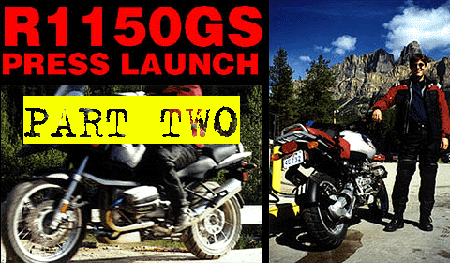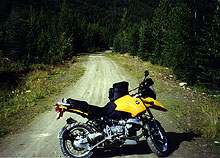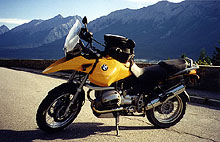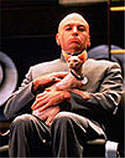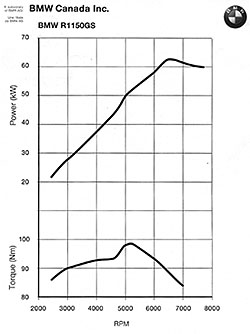|
|
|||||||||||||||||||||||||||||||||||||||||
|
BMW
R1150GS By Rob Harris
On the face of it there seems to be little change to the 2000 GS, and in reality the new GS is more evolution than revolution, with many parts updated using newer technology currently found on many 99 models. For now however, let's focus on the changes done and some riding impressions made during the Calgary press launch a couple of weeks ago. Due to the brief and, ehem, luxurious manner of the launch, it would be foolish to try and draw too many conclusions at this stage. Those will have to wait until we get our grubby hands on the bugger for a couple of mossie munching, kraft dinner chomping, no frill weeks. I can remember when the first BMW GS (R80) came out in the early eighties and thinking how absurd it seemed. A big bore opposed twin trying to be a dirt bike? For starters it weighs far too much, the tires will instantly clog up with dirt and those sticky out cylinders will get stuck between trees. Madness!
I missed the point and I think a lot of people did and still do. In a world of increasingly specialised motorcycles the GS simply didn't fit into standard categories. It's not a dirt bike. Nor is it a tourer. Definitely not sports ... and cruiser? I think not. Actually it's a bit of all of these and the result is a jack of all trades, but master of none. Which usually suggests a bad connotation, but in the real world (which I occasionally visit) it's really what you want. BMW describe this category as 'adventure touring' which I would tend to agree with. If I had to do a round the world trip then this is the kind of bike that I'd like to take. Of course, in the financial world of 'arris, I maybe able to scrape up the air fare for the occasional exotic trip, but the rest is definitely on a shoestring budget. A trip last year to Australia saw me with an old Yamaha FJ1200 (a very usable touring bike), but on our various expeditions down gravel roads, the FJ could only gawp at the 100Km/h signed limits as it cautiously weaved its merry way at a maximum 50. Funds allowing, this would have been perfect GS territory.
There are other bikes that now fit into this category, like the Triumph Tiger and Honda's Africa Twin to name but a couple, but I believe the GS invented it and I also believe this article is about the GS, so we won't go there right now (plus the Japanese manufacturers can't seem to establish their models in Canada). With some new developments coming in with recent models such as the K series bikes and the R1100S Sports boxer and R1200C Cruiser, BMW have opted to pick some of the best parts of each model and apply them to the new GS. For instance, if you've ridden any of the pre 99 model boxers before you will have noticed that the box is clunky, stiff and prone to false neutrals. If you've ridden either the R1100S or K models, then conversely you would have noticed that BM can indeed build a decent box. Thankfully, the GS gets the new six speed version with ratios one to five closer spaced than the old GS, the new sixth gear being an overdrive for more relaxed highway cruising (and it is).
An increase in capacity from 1085cc to 1130cc is achieved by using the 2mm larger cylinders from the R1200C. Add to this revised camshaft timing and a new exhaust system and you get a peak torque figure of 98Nm/73ftlb (87Nm of which is available from 3000rpm) and peak power of 85hp (up 5hp from the previous GS). Actually, I'd liked to have seen the complete exhaust system of the R1100S fitted - under seat tail pipe and all. Now that would be a sexy machine. One cosmetic and functionally superior item to be lifted directly from the S are the assembled (instead of cast) telelever sliders. Not only do they save just over a Kg in unsprung weight, but they also look a lot more like conventional upside down forks. The cast telelevers bulge in the middle and taper off to both ends, which may be technically correct when considering bending moments, but they just look so damn ugly. However, front travel remains the same at 120mm with adjustable preload and rebound damping. The rear paralever is shorter and now pivots directly from the transmission casing. The single sidedness of it's nature, along with the new pipe, allow removal of the rear wheel without removing any other parts ... except for the wheel nut I guess. BMW's ABS comes as optional equipment but although pricey ($1,780), works very well. Our test bikes came with it on and interestingly so did a de-activation button to allow the rider to lock the rear in the dirt for some trick rear wheel steering. Unfortunately, I could never get it to deactivate for long. It always seemed to reactivate itself eventually, which wasn't too bad because I soon discovered that ABS is really quite nice in the dirt if you're actually a crap dirt rider like myself. As far as bodywork goes, the main changes occur at the front. The upper fender (the long beak like bit) now ducts air into the new oil cooler, which is located just underneath the new twin headlights (with episoidal low beam, don't you know). These in turn sit under the new three way adjustable screen, which does a surprisingly good job at keeping the wind blast off and is really quiet (try the R1100S to see, I mean hear how noisy a screen can be at speed). Unfortunately the three way adjustments seem to do a surprisingly good job of nothing much at all, except pivot the screen slightly forward or backward - and they need a torx tool to do that too. However, the screen can be removed quickly and easily if desired, although I'm not sure why you would want to do that. Moving over to the rear and we have a two height adjustable seat. This allows a seat height of either 840 or 860mm, which didn't really seem to make a difference to me, but then if you're short in the leg department, it might be everything. Actually, if you're quite short in the leg then you might not be able to fit on this machine at all. However, there is an optional 30mm lower seat available, but it's unclear whether that would make it 810mm or 830mm, or both (if it too is adjustable). The possibilities astound. On a comfort scale of 1 to 10, I'd give it an 7.5. I felt a bit uncomfortable after about 160Km but then it didn't seem to get any worse for the rest of the day, and was not an overriding factor for stopping. Something else worthy of mention in the seat department is the the removable rear section. Step one makes it into an additional big rack for the round the world solo adventurer type who needs extra space, and step two reveals a comprehensive tool kit under the rack. It's like appetiser, entree and desert all in one, with maybe a wafer thin mint at the end (that would be the excellent BMW puncture repair kit). Other noteworthys include the toasty heated hand grips as standard, a roll over valve in the fuel tank (to prevent Mad Max like spillage and subsequent flame broiling of the trapped rider), no engine cutout when the side stand is down (which the old R series did and was a real pain) and fitments to allow the installation of the BMW System cases. Talking of which they're a bit like the K1200RS cases, in that the left box has reduced capacity (25L instead of 31L) due to the upswept exhaust and cost an additional $990.00. Presumably it also has the tendency to heat up it's contents, so carry Mr. Bigglesworth in the right (you know, Dr. Evils cat? Austin Powers? The spy who shagged me? C'mon, throw me a friggin' bone here).
Other options include cylinder protection hoops ($381.00), plastic valve cover guards, crappy tank bag (we'll it was okay but it didn't have a carrying handle for buggerys sake and is well over priced at $400.00), removable 35L top case and hand guards - well I presume they're options. Our bikes came with them fitted and they look the biz. Unfortunately, I found them a bit low and so exposed the knuckles to the wind and they also failed to prevent some minor front master cylinder damage when one rider dropped it in the dirt. Suggested list price is $16,700 which is a whole $3,000 dollars up on the Triumph Tiger. We hope to be able to get hold of the GS again in the near future for a more lengthy and real life test. Until then, if you want more and missed the write up on the events of the Calgary launch then simply click here ... err, no here. Specifications:
|
© 1999 Canadian
Motorcycle Guide Online
